mission accomplished
July 13, 2007

The dragonflies and damselflies are out again with the good weather. It seems quite poetic as they also came out for the beginning of my residency. Today was my first sighting of a male libellula depressa since my first visit to ‘La Cité‘; however, this time it was accompanied by a host of Azure Damselflies (coenagrion puella). These make a quieter and higher pitched sound than the dragonflies and are a real challenge to record!
Luckily, for me, my composition is now complete!! In fact, tonight is the launch of my sound installation, and so it’s a busy day ahead, not only in the creating of the surround sound DVD which will power the installation but also in the presentation of the visual element and accompanying project information.
END OF BLOG
a step too far
July 12, 2007
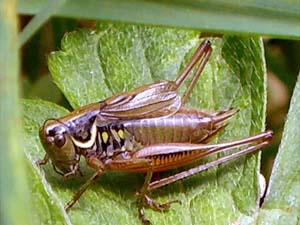
It’s been a beautiful warm day today, well at least from this afternoon onwards, and as a result the insects are a plenty. As the day heated up not only did the insects become to be more abundant, but the crickets and grasshoppers also increased the speed of their chirps. This is because their song is affected by temperature: as temperature drops their chirps slow down, and at the other extreme, when it gets too hot they conserve their energy and stop singing.
In fact, it is actually possible to tell the temperature by counting the number of cricket chirps. Simply count the number of chirps a cricket makes in just over eight seconds, add 4 to your result, and you have the temperature in degrees centigrade. It was a physicist named Amos Dolbear who first came up with the formula at the turn of the 20th Century, in 1897, publishing it in a paper entitled, “The Cricket as Thermometer” and giving it the name of Dolbear’s law.
Not all species of cricket respond in the same way, however, and so if you want to try this at home, it is probably best to experiment with a thermometer first to gauge how your local crickets react to the the temperature. Also, be aware that some crickets are more reliable than others as they inconveniently change their rate chirp depending on their mating status and also as they get older.
A variation of the formula would also work for ants footsteps, if it was possible to measure them as they also follow the Arrhenius equation closely, but that’s probably going too far!
swimming silently
July 11, 2007

Away from the complex sound world of the garden’s insects, the notonecta glauca hangs from the surface tension of the water in the pond doing the backstroke. Of all the insects, it seems to be the most relaxed: mostly floating and occasionally flicking its ‘oars’ to propel it a little further along.
Although many insects make intentional sound (that is other than that produced by their normal activities, such as eating, walking and flying) we are not sure exactly what it is that they perceive. Most probably they are able to hear within the frequency range of what they themselves produce, but what exactly that ‘sounds’ like we do not know. Although it is reasonable to presume that the functions of producing sound and perceiving sound go hand-in-hand, insects have been discovered that have the capability to hear and yet appear to produce no sound, at least it has not yet been detected.
For those insects such as the notonecta therefore, I wonder what their world sounds like. Certainly they react to visual stimulus as well as being tuned in to the ripples that their prey makes when falling onto the water’s surface just in time for dinner, but is it a silent meal?
tuning in
July 10, 2007
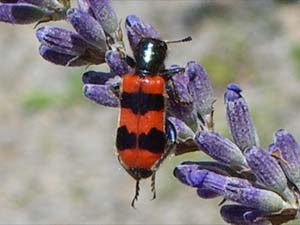
Red and black colouring apparently signifies “not very tasty” to hungry birds. As a result, perhaps, they are often more out in the open than the less colourful variety. Maybe, as well, for this reason they also don’t need to rely so much on acoustic communication as they can easily be visually identified by their potential mates.
During my stay here, as I have been tuning my listening in to this micro world that surrounds me, I have been amazed at how much detail is there and how much information there is to pick up on. I find myself fascinated by the pitch of those insects that fly past me, by the rhythms of the crickets and grasshoppers, the spacing between the different calls, and what all these things may signify.
As I research the phonotactic behavior employed by these creatures it is clear that there is so much to learn, not only about the insects themselves, but also something about the actual nature of sound and possibly even some of the reasons behind its different functions.
insect guide to making sound and staying alive
July 9, 2007
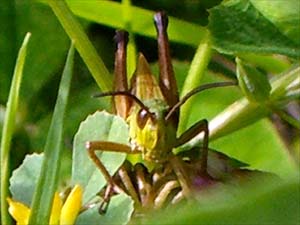
Emit narrow band high frequency sounds so as to limit any phase difference recognition useful for direction finding.
Use sounds that lack transients or amplitude modulation.
Make use of the resonance of a larger object so that your sound appears to come from a wider area.
Broadcast in short bursts of sound, with long intervals in between, to provide minimum information for impatient predators.
reasons to make a sound (if you’re an insect)!
July 8, 2007
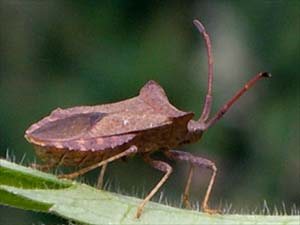
to startle a would-be predator
to pretend to be something else
to warn against an aggressor
to deafen a potential rival
to stake and maintain your territory and individual space
to signal species identity
to attract a potential mate
to drown out the female reply to a rival
metamorphosis
July 7, 2007
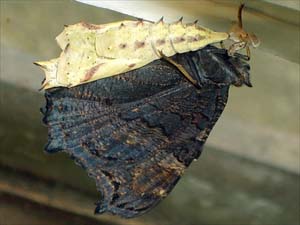
Today the peacock butterflies (inachis io) came out of their chrysalises – seven in all. It was a strange sight to watch: like seven escape artists one by one swinging in their cocoons trying to break them open. Then, with the wings unfolded, the butterflies spent a good hour getting used to their new bodies before flying away, moving a leg here, an antennae there, testing the proboscis and finally opening and flapping their wings before beginning their new life.
Although generally silent creatures they do use sound as a protection against predators. In this case, it is in the form of an ultrasonic series of clicks (of between 30 and 60 kHz) created by the rubbing together of their wings as they are flicked open to reveal the large ‘eyes’ on their brightly coloured open wings. Enough to give a scare and hopefully some time to escape.
wing beats
July 6, 2007
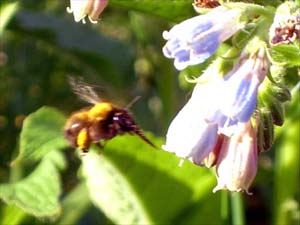
I have been making recordings of various flying insects. Although each tends to produce a range of pitches, depending on what they are doing, they do all appear to inhabit their own peculiar pitch territories. Interestingly (so far at least) I have found that these pitches do not appear to be evenly spread over the frequency spectrum but instead sort themselves into groups.
So far, the lowest pitch belongs to the macroglossum stellatarum which emits a fairly constant low E (one stave below the bass clef). This is shared by the libellula depressa who also hovers around this note, but with more clackety wing noise. Up a minor third is the xylocopa violacea (on a G) and sharing its pitch territory with the phyllopertha horticula (on an Ab) and the vespa crabo (on an A). Up a further augmented fourth is the bumble bee (as yet not identified – there are about fifty different species!) which seems to buzz around Eb, and up another major third is the apis mellifera. Finally (so far!) there is the bombylius major buzzing on a Bb (resting on top of the bass clef) and the vespula vulgaris on a B.
From knowing the pitches of the various buzzes, it is possible to then estimate the number of wing beats per second. Hence my recorded insects were beating their wings in the range of around 40 times a second for the libellula depressa and about 250 times per second for the vespula vulgaris. Apparently this increase of wing speed as the insects get smaller is because aerodynamic performance decreases with size, and so to compensate they have to flap faster.
low hum
July 5, 2007

Perhaps the most impressive insect in the garden at the moment is the macroglossum stellatarum (hummingbird hawk-moth). It seems to like the lavender at the front of the house, and can be found there from time to time hovering around the purple flowers. It always appears to be on the move, darting in and out and probing for nectar or pollen by means of a proboscis that is almost as long as its body, no doubt enabling it to reach for food that is out of range of many other insects.
As it flies, its wings make a soft low hum around the E below the bass clef, similar to the dragonfly mentioned below, but without the clatter of the dragonfly’s wing noise. So far, these two insects are contenders for the prize of lowest pitched buzz.
ultrasonic chirps
July 4, 2007
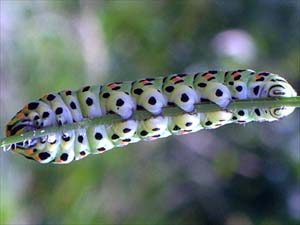
I continued my research into ants and ultrasound last night and eventually discovered some papers on the subject. It appears, after all, that some ants, at least, do make sound by using stridulation, although whether they do this to communicate with each other (for example as a distress call) or as some sort of echo-location system it is not known. This would help to explain why my signal was made up of a repetition of the same note, each one being a separate ‘chirp’ component of the whole call.
Ultrasonic sounds are not uncommon in the insect world, or for that matter everyday recording. Normally though they are simply part of the frequency range of an already audible signal, such as sibilance when people speak, or the call of a cricket. What was most exciting about this find is that it could be a ‘hidden’ message totally out of the range of human hearing.
I have found some research by a Dr Hickling who recorded stridulation sounds of Black Fire Ants. Although these are a different species, I do think there are similarities in the sounds. I think mine is similar to the one he calls the ‘all is well’ signal. Check out his recordings here.
microphone is heavy
July 3, 2007

Today I have been editing recordings taken from a formica rufa (wood ant) nest. Within seconds of placing the microphone on the nest the ants were all over it, and so it was easy to record the ants moving and doing what they do. I also experimented with miking up a dried leaf and recording the ants walking over that.
These particular ants are quite small (I have recorded heavier) and so I wasn’t able to record each ant’s individual steps as I had hoped. I could however get a workable recording level when many ants were walking, although I had to keep remembering to keep my distance as these ants are very inquisitive, and they bite. (They use formic acid – the same as stinging nettles).
Interestingly when I was doing my editing I noticed a (very) occasional ultrasonic signal at about 31kHz, the main part of which was a six-note phrase, all on the same note, and with the rhythm of “microphone is heavy”. The strange thing is that from reading the literature on this ant (and ants in general) I have not been able to find any references to ultrasound transmission, and so I don’t know….. was it from the ants, and if not where did my ultrasonic signal come from? Listen to a recording of it (at roughly a fortieth of the speed and pitch) here.
depressed?
July 2, 2007
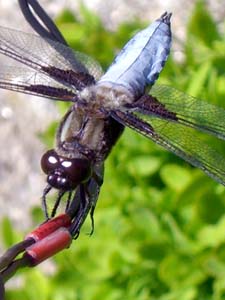
The dragonflies that frequent one of the small ponds in ‘La Cité’ go under the name of libellula depressa, or depressed dragonfly. This year because of the bad weather the females took longer to arrive. This is good news for the males because more or less as soon as they have mated, they die. So they got a few extra weeks of flying around until the females arrived.
The blue males hang around the pond and stake their territory, waiting for the smaller yellow coloured female to arrive. The sound of the male’s flight is very quiet and low in pitch (around the note E on the first stave below the bass clef) and you can only just about hear them when they swoop past. The female is even quieter. However, when the two of them mate they do so in flight joining together at both ends (forming a sort of ring) and with both insects flying in unison and colliding wings there is a short twenty second burst of noise before they separate.
This is immediately followed by the female laying her eggs in the pond, hovering above the water and slowing her wing speed down so that she dips into the water and then increasing the wing speed to fly to another part of the pond to dip again. This succession of audible glissandi is accompanied by the swooping sound of the male dragonfly as he takes guard, and then the show is over: they separate and the pond is quiet again.
entomophonix
July 1, 2007

Day One at ‘La Cité des Insectes‘. I am here to create a sound installation for their museum. Although the weather is reasonable today, because is it has been so rainy much of the ambient insect soundscape is very minimal. The field crickets have stopped singing and there just isn’t the ‘buzz’ one might expect from this time of year.
The lime tree, just outside the museum, however, is in full blossom and as such is a major attractor to the bees, and I’m sure wasps, hornets, and so on. There must be thousands of these insects in the tree, as there is a constant hum emanating from the branches throughout the day.